The mattress industry is focused on putting together the mattresses that give consumers a good night’s sleep. But in a circular economy, how those mattresses get taken apart at the end of their useful lives matters, too. We talk to recyclers about their process, challenges and thoughts on the future.
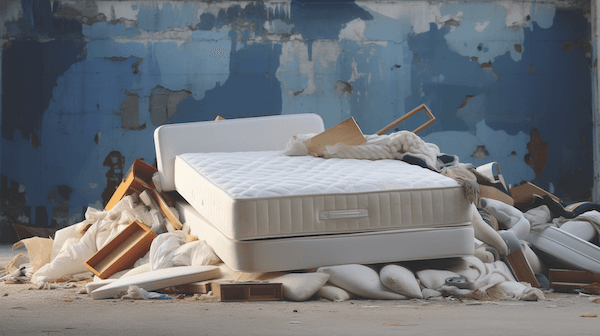
While the manufacturing plants that give birth to new mattresses are increasingly automated, the facilities that dismantle those mattresses for recycling at the end of their useful lives are still mostly manual operations. Think employees with utility knives, cutting, ripping and separating bedding components into piles.
Mike Crowell, market area manager for Rutland, Vermont-based Casella Waste Systems Inc., which operates a mattress recycling facility in Willimantic, Connecticut, estimates that 90% of the disassembly process is manual.
But U.S. recyclers say they will be able to invest in automation if demand for recycling services grows in response to consumers becoming more concerned about issues of sustainability, landfills stop taking bulky items like mattresses, and additional states join California, Connecticut, Oregon and Rhode Island in creating statewide mattress recycling programs.
For example, as mattress recycling expands, investing in new automated systems for dismantling pocketed coil units can become more cost effective, recyclers say.
Most mattress producers — and their suppliers — spend far more time paying attention to what happens on their own factory floors than thinking about what happens at a recycling facility down the road.
That is understandable, but that is changing, too, as the sleep products industry embraces the concept of sustainability and strives to reduce waste, energy use and emissions across the supply chain while finding new uses for mattress components at their end of life.
So, BedTimes talked with U.S. mattress recyclers about what happens, step by step, at their facilities, the challenges they face, the opportunities they see ahead — and why they think it’s important that the rest of the mattress industry know what they do.
The first steps
Mattresses are big and bulky, so a facility that dismantles them for recycling needs to be “a large, open space with high ceilings, which helps with fire safety and prevention,” says Michelle Williams, president of Mat Recyclers, which has an approximately 60,000-square-foot facility in Rancho Cucamonga, California. The only other significant requirement: loading docks for the trucks bringing units into the facility and the commodities buyers’ trucks taking the disassembled components back out to be recycled into new products.
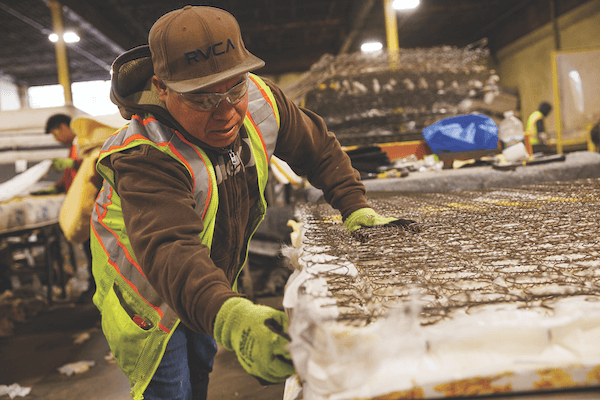
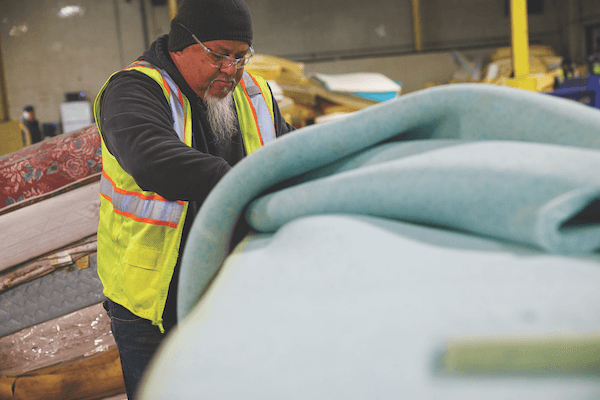
In the case of recyclers in California, Connecticut, Rhode Island and soon to be Oregon, most mattresses arrive via the Mattress Recycling Council, which administers these statewide recycling programs and contracts. Mattresses are collected from a variety of sources including waste transfer stations, public collection events and large volume sources like mattress retailers, hospitals, hotels and universities. MRC also contracts with transporters in each state to move discarded mattresses to the nearest recycling facility.
Once the used mattresses are counted and unloaded, they are stacked near the workstations of employees, where workers then use utility knives to cut and rip them apart into components.
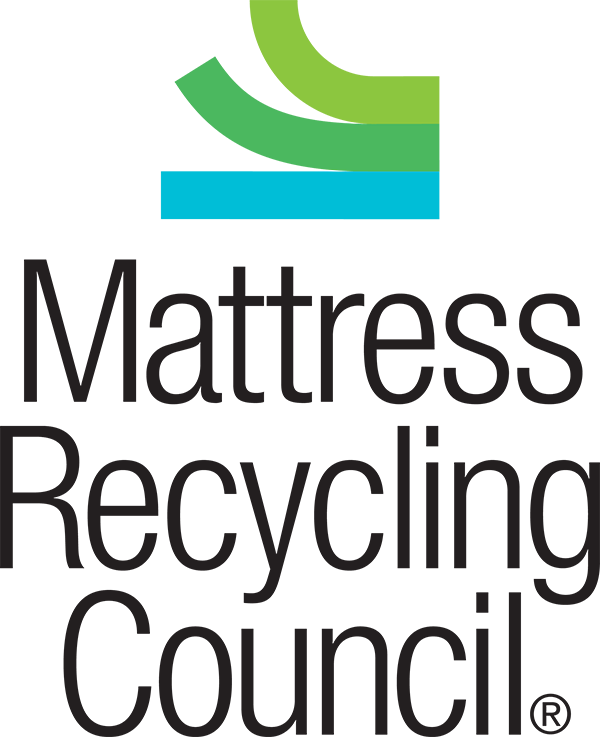
More Than a Manager: The Mattress Recycling Council, a nonprofit created in 2013 by the International Sleep Products Association to implement statewide recycling programs, does more than manage the ins and outs of those efforts. MRC invests nearly $1 million a year to develop efficiencies in mattress collection, transportation, and deconstruction and research new and better uses for recycled materials. For example, an MRC grant helped develop a prototype machine to dismantle pocketed coil units. Learn more at MattressRecyclingCouncil.org.
Matt Baltz, operations manager at the Casella-owned mattress recycling facility in Willimantic, says the process can look “barbaric” but that it’s effective. Casella is one of the largest solid waste management companies in the United States, serving residential, commercial, municipal, institutional and industrial customers in more than 40 states. It also operates a smaller mattress recycling facility in Buffalo, New York.
As they disassemble the beds — Baltz and the Casella team call the process “decasing” — workers stack similar materials (quilt, foam, innerspring units, pocketed coils, cotton, shoddy, etc.) in piles around their workstations.
Casella operates two dismantling lines at its 18,000- square-foot facility in Willimantic. The facility recycles about 65% of the mattresses in Connecticut, Crowell says, but also takes in mattresses from other Casella facilities in Maine, New Hampshire, New York, Vermont and soon Pennsylvania. Through those streams, the facility processed about 150,000 mattresses in 2022 and 184,000 last year.
Williams compares the process of dismantling a mattress to “disassembling a sandwich — taking the bread and meat and cheese layers apart — because each layer of the mattress is disposed of differently.”
“Or think of it like opening an Amazon package,” she continues. “You open the cardboard box, separate the plastic insulating materials out, take the product out of the packaging and then dispose of each of those materials differently. It doesn’t matter if it’s a king size, queen size or a mattress from a cruise ship or a hospital. They all get dismantled the same way.”
Experienced employees work quickly. Williams says the most efficient members of her 24-person team can dismantle 100 mattresses in a shift.
“They are incredibly efficient because you’re not trying to maintain the integrity of the pieces, right? You want the components as whole as possible if you are going to be baling them, but it isn’t a finesse activity where you have to worry about clean stitch breaks or things like that,” she says.
At this early dismantling stage of the mattress recycling process, safety is as important as speed. “We’re most concerned about getting the mattress dismantled as quickly as possible but doing it safely, so nobody gets hurt in the process,” Williams says. In addition to using utility knives, employees wear gloves and eye protection. Casella’s workers also wear Kevlar sleeves, Baltz notes.
Automation aids
As workers accumulate piles of components around their workstations, forklift operators pick up those stacks, moving the materials to the next stage of the process. And that’s where some automation can come in.
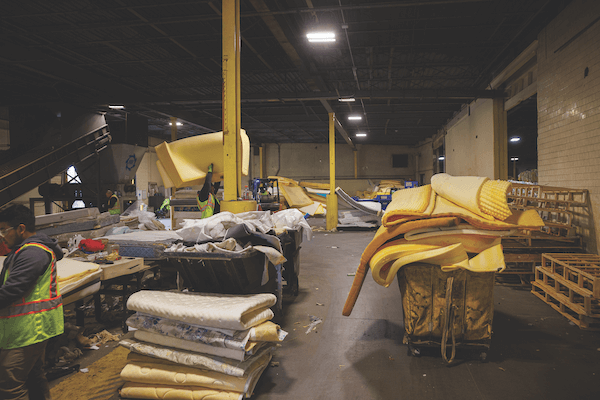
U.S. recyclers use machines to separate the steel springs from the wood in traditional box spring units. Larger recyclers are now using industrial shredders to ready the steel and some other components for sale to end markets.
Pocketed coil units have been a problem for mattress recyclers, as it is difficult to separate the polypropylene fabric from the steel and far too many have ended up in landfills. But this is an area where advancements in shredding automation are proving useful — and profitable.
In late 2023, Casella installed an automated system from Florence, Kentucky-based Pocket Coil Recycling in its Willimantic mattress recycling facility to dismantle and separate pocketed coil units into steel and polypropylene fabric, which are among the most lucrative mattress components. Crowell says the system can process 32 pocketed coil units an hour: “We stock up about 500 units and then run it in a two-shift period.”
“I couldn’t believe the effectiveness of the system,” Crowell says. “We estimated (that before installing the machinery) we were disposing of 40 tons of pocketed coils a month because we couldn’t handle them. And now we’re capturing that metal and polypropylene (for resale to commodities brokers). We’re very excited with the results that we’re achieving.”
Currently, Mat Recyclers outsources pocketed coil recycling to another California recycler but hopes soon to purchase a pocketed coil machine to dismantle those units in-house — and profit from the steel and polypropylene fabric.
As for that initial stage of dismantling, now handled manually in the United States, Crowell notes that there are “automated systems in use in Europe that will fully decase a mattress, separating all the mix of products coming out of it — the foam, the topper fabric, the shoddy, the jute.” But, for now, those systems are too pricey to be cost effective for most U.S. recyclers.
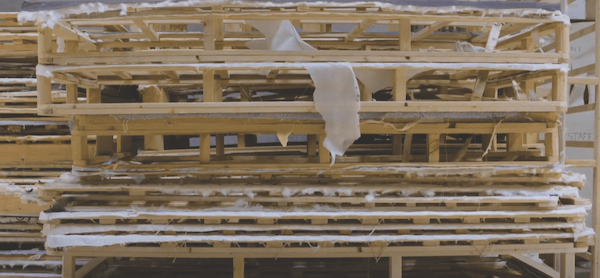

including investigations into new and better uses for used mattress components.
And Williams isn’t sure that an automated system would be much better than the current method, which she calls “highly efficient.” “Honestly, I don’t know if a machine could do the same volume,” she says. “And the other problem is that there is a real lack of uniformity within a (domestic) mattress. It’s not just the various sizes — everything from a hospital bed to a California king — but almost every mattress is different in terms of how it’s assembled. The quilts are different, the adhesives are different, the layers of foams, the types of foams, the types of coils. There are just so many different elements, assembled differently — more variety than in the European bedding market (where foam units are more prevalent), I think.”
But Crowell expects U.S. recyclers to continue to add technology and automation as recycling volume grows. Casella, he says, is committed to investing in mattress recycling, and in making the process more efficient and cost-effective.
Variable markets
Once components are stacked, shredded, baled or otherwise prepped, they are picked up by commodities buyers. The frequency of pickups depends on the amount and type of material collected, recyclers say. Some commodities buyers pick up loads several times a week; other components get picked up weekly, biweekly, monthly or even less frequently. For instance, until Mat Recyclers buys its own machine to dismantle pocketed coil units, it has those bulky items picked up several times a week to save space and keep its facility operating efficiently.

Adrienne Farrar Houël is president and CEO of Greater Bridgeport Community Enterprises Inc., a nonprofit community development corporation focused on energy conservation that operates the Park City Green mattress recycling division in Bridgeport, Connecticut, operates similarly.
“Pickup times vary widely,” Houël says. “… But nothing is kept here for very long. We don’t want stuff sitting around.”
Commodities markets fluctuate, but recyclers say steel is generally the most profitable component.
“It’s consistently at the high end,” Houël says. “Right now, it’s $210 a ton, so it’s pretty lucrative.”
Shoddy and coir (a coconut fiber) are always difficult to find a buyer for, Crowell says, and lately, the market for polyurethane foam has been weak. That foam is used to make carpet pad, and when residential housing and commercial building markets cool, so does demand for carpet and carpet pad. (See story on page 32 about the Mattress Recycling Council’s efforts to find markets for mattress materials.)
Cotton can be bothersome for recyclers because it’s not captured in high volumes in old mattresses and there isn’t a big post-consumer market for it.
“You run across it, but there isn’t enough cotton to negotiate for pickup once or twice a month, so you have it sitting around for six months before getting enough to fill a truck,” Houël says. “And it’s very cheap in terms of the commodities market: It runs between 4 cents and 6 cents a pound.”
Crowell says Casella’s Willimantic facility benefits from its proximity to both a Casella-owned metals yard and a construction recycling facility. All its shredded and baled metal goes to the metals yard, from which it makes its way to steel mills and foundries. Wood from mattress foundations is either shredded and used for biomass fuel or used for mulch applications.
Working together
Mattress recyclers acknowledge that mattress manufacturers’ priority should be creating the quality, supportive mattresses that give consumers a good night’s sleep. But they are pleased to see both producers and their suppliers taking an interest in mattress end-of-life issues.

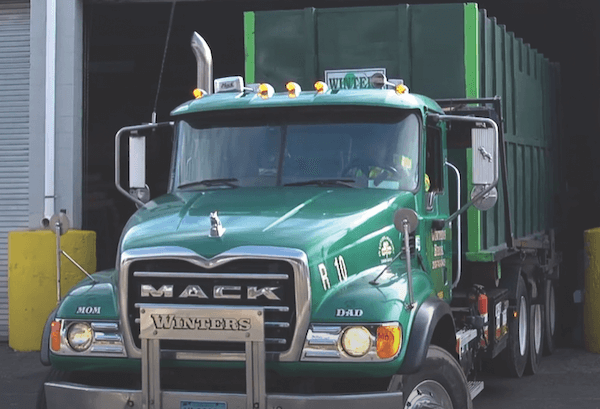
In states with mattress recycling laws, loading docks at
mattress recyclers accept units from both private waste haulers and those who contract with MRC.
By better understanding the challenges recyclers face, including finding markets for some components, manufacturers may be able to adjust both the materials they use and their construction methods. For instance, knowing the difficulty of dismantling pocketed coil units, springs makers are coming up with new materials and constructions that make the separation process easier.
To help raise awareness about recycling challenges among mattress manufacturers, MRC and ISPA facilitate discussions among recyclers and manufacturers at the ISPA Sustainability Conference and host tours for interested ISPA members at recycling facilities.
Additionally, MRC has assembled two workgroups to spur discussions on the deconstruction and recycling of mattresses and encourage manufacturers and suppliers to address end-of-life issues.
The industry workgroup on circular design helps members of the value chain consider end-of-life recycling challenges when designing new components and mattresses. MRC shares lessons learned from mattress deconstruction and recycling to help find strategies to reduce waste and enable more and higher-value recycling of mattress components.

The industry workgroup on new materials identifies new components or technologies recently introduced to the market that may pose recycling challenges. It also advises MRC on anticipated long-term changes in product mix and raises industry awareness about how design and marketing decisions can affect recycling. Ultimately, this type of information helps MRC’s researcher team and recyclers prepare for the future.
If recyclers know what components are popular in today’s mattresses, they have time to respond to any potential challenges ahead, given the relatively long lag between when most consumers purchase a mattress and when they dispose of it. (The average age of a discarded mattress received by MRC recyclers today is 13.9 years.)
“We can have 10 years between when you manufacture a new mattress and when I receive it at my recycling facility — that’s 10 years to develop a solution,” Williams says. “… There needs to be understanding on both sides — the assembly and the disassembly process — to make the right trade-offs.”
For more in-depth coverage, see “Taking It All Apart” in the digital edition of BedTimes magazine.




